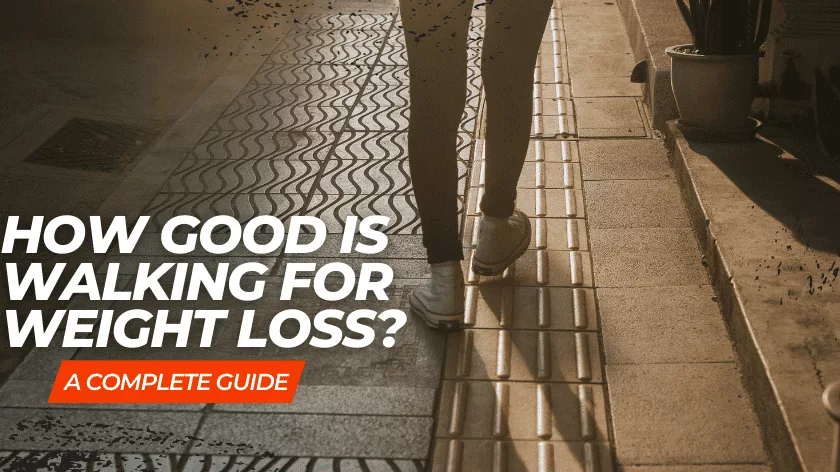Starting your weight loss journey can be daunting, but it’s important to remember that even small changes can lead to a happier and healthier lifestyle.
You may think you have to commit to hours at the gym or give up all your favorite foods, but that’s not necessarily true! In fact, one of the simplest and most effective ways to start losing weight is by walking.
Regardless of your ability level, walking is a great way to boost calorie burn and get your heart rate up. And the best part is, it’s something you can do anywhere, anytime!
So, just how good is walking for weight loss? Let’s take a closer look.
5 Benefits of Walking for Weight Loss
1. Increases Energy Levels
There’s nothing worse than dragging yourself through your day, feeling exhausted and run down. That’s enough to put anyone off working out! But the good news is you can ramp up your energy levels by going for a walk.
Regular walking can have a positive effect on energy levels and reduce fatigue. So if you’re sitting at your desk struggling to concentrate on even the simplest task, go for a quick walk around the block. You’ll come back feeling refreshed and ready to take on the rest of your day.
2. Boosts Your Metabolism
Let’s face it: we all want to boost our metabolism. And, while there’s no magic pill that will speed up our metabolism overnight, there are certain lifestyle choices we can make – one of those choices is walking.
Taking a brisk walk for 30 minutes daily can help increase your metabolism so you can get the ball rolling on your weight loss journey. Of course, you’ll need to ensure you’re in a consistent calorie deficit, but a little extra help from your metabolism can’t hurt!
3. Improves Heart Health
The low-impact nature of walking makes it an ideal form of exercise for anyone aiming to improve their heart health. Walking has been shown to lower blood pressure and cholesterol levels, both of which can lead to heart disease in excess.
Particularly if you’re overweight or obese, getting your heart health in check is an important first step to improving your overall health. It doesn’t have to be complicated or time-consuming – a simple walking routine can make a big difference.
4. Lowers Blood Sugar Levels
Most people know that walking is good for their health. But did you know that walking can also help to lower blood sugar levels?
Numerous studies have shown that a brisk walk can help to increase insulin sensitivity and decrease blood sugar levels.
And even a short walk can have benefits. One study found that just 2 minutes of walking after eating can help lower blood sugar [1].
So next time you feel a sugar craving coming on, take a walk instead. It just might do the trick!
5. Improves Mental Health
Walking is not only good for your physical health but can also do wonders for your mental well-being. Numerous studies have shown that a daily walk can help to improve mood, reduce stress levels, and boost cognitive function.
And there’s no need to go on a lengthy hike or join a gym; even a short walk around the block can have benefits. So next time you’re feeling down or struggling to concentrate, lace up your sneakers and take a stroll. Your mind will thank you for it.
How to Make Walking Part of Your Day
Walking is one of the easiest and most effective forms of exercise, yet many people find it challenging to make time for a walk daily. Luckily, it’s simple to fit walking into your day, even if you don’t have time for a dedicated walk.
You can do this by taking a brisk walk every time you need to leave the house, whether running errands or picking up the kids from school. If you work from home, take a break from your desk every hour or so and walk around the block or up and down the stairs.
And if you have young children and/or a dog, take them for a walk in the park or around the neighborhood. The fresh air will do you good!
Walking For Weight Loss: The Importance of Diet
If you’re looking to lose weight, choosing the right snacks to fuel your body before and after a walk is important. Just as you wouldn’t put regular gasoline in a high-end car, you wouldn’t want to eat just any old thing before hitting the pavement.
Ideally, you want something that will give you sustained energy without weighing you down. A piece of fruit or a small handful of nuts is a perfect pre-walk snack.
And when it comes to post-walk refueling, look for something with protein and healthy carbs to help your muscles recover. Greek yogurt or a protein shake are good options.
Just be sure to avoid processed snacks high in sugar – they might give you an energy boost initially, but you’ll crash soon after. So instead of reaching for a candy bar, opt for something that will help you reach your weight loss goals.
6 Tips for Getting The Best Results from Walking for Weight Loss
1. Start Slow
If you’re new to walking for weight loss, starting slow is important. Walking at a moderate pace for 30 minutes a day is a great way to get started. Once you’ve built up your endurance, you can start walking for longer periods of time or at a faster pace.
2. Wear the Right Shoes
Wearing the right shoes is important when you’re walking for weight loss. Choose shoes that are comfortable and provide support for your feet. Additionally, make sure to wear socks that wick away moisture to prevent blisters.
3. Walk with Good posture
Walking with good posture is important to get the most out of your walk. Stand up straight, keep your shoulders back, swing your arms as you walk, and take long strides. Doing so will help you burn more calories and tone your legs.
4. Find a Walking Partner
Finding a walking partner can help you stay motivated and on track with your weight loss goals. If you don’t have a friend or family member interested in walking with you, consider joining a local walking group or looking for a walking buddy online.
5. Set Realistic Goals
When setting goals for your walking program, be realistic about what you can achieve. If you set goals that are too ambitious, you may get discouraged and give up on your program altogether. However, if your goals are realistic and achievable, you’ll be more likely to stick with your schedule and see results over time.
6. Reward Yourself
Finally, remember to reward yourself for sticking with your walking program! After reaching milestones like walking for 30 days straight or losing 10 pounds, treat yourself to a new pair of shoes or some new workout clothes
How Good Is Walking For Weight Loss? – The Bottom Line
Walking is a great exercise to add to your routine, whether you’re looking to lose weight, get fit, or improve your overall health. And considering all the benefits that walking has to offer, it’s definitely worth giving it a try. So get out there and start putting one foot in front of the other – you’ll be surprised at how good it feels!
FAQs
Does Slow Walking Burn Belly Fat?
Yes, walking at any pace can help burn belly fat. However, if you walk at a slow, leisurely pace, you may not burn as many calories as you would if you walked at a faster pace. Keep in mind, however, that you can’t spot-reduce fat, so you’ll need to focus on overall weight loss.
Does Walking Burn Fat On Thighs
Walking is a great way to lose weight and tone your legs. However, you can’t target specific areas of your body for fat loss. If it were that easy, everyone would have a thigh gap! So instead of trying to spot-reduce fat on your thighs, focus on overall weight loss and toning your legs with strength training exercises.
How Many Calories Does Walking Burn?
The number of calories you burn while walking depends on several factors, including your weight, the intensity of your walk, and the length of time you’re walking. However, a general estimate is around 100 calories burned per mile [2].
Does Walking 1 Hour Every Day Aid Weight Loss?
Any amount of walking is better than no walking, but if you want to see real results, aim for at least 30 minutes a day. This can be broken up into 10-minute increments throughout the day or done all at once. If you can walk for longer periods, even better! Just remember to listen to your body and take breaks as needed.
How much weight can someone lose in a month by walking?
That’s like asking how long is a piece of string! But in all seriousness, it depends on how much you weigh, how fast you walk, and for how long. But you can actually lose a fair amount of weight in a month if you commit to walking regularly.
How much walking do you have to do to lose weight?
Again, it depends on your starting weight, how fast you walk, and how long you walk. But as a general rule of thumb, you need to burn more calories than you consume to lose weight. You can achieve a calorie deficit by eating less, exercising more, or combining both.
Can walking 10,000 steps daily help you reach your goal weight?
Yes, walking 10,000 steps a day can help you reach your weight loss goals. But it’s not just the number of steps that matters – it’s also the intensity of your walk and the length of time you walk for. So if you’re looking to lose weight, aim for at least 30 minutes of walking at a moderate to vigorous pace.





Leave a Reply